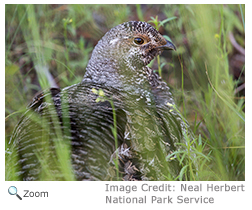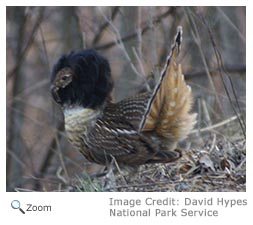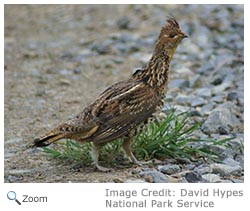Characteristics
 The ruffed grouse is a chicken-sized bird about 16-19 inches in length. It has reddish-brown to gray-brown plumage and a short crest on its head. It has barred flanks and a black ruff around its neck. It has a short, pointed bill and a long, square, flat tail. The ruffed grouse is a chicken-sized bird about 16-19 inches in length. It has reddish-brown to gray-brown plumage and a short crest on its head. It has barred flanks and a black ruff around its neck. It has a short, pointed bill and a long, square, flat tail.
Range
 The ruffed grouse can be found in Alaska and Canada south to California, Wyoming, Minnesota, Missouri, and the Carolinas. The ruffed grouse can be found in Alaska and Canada south to California, Wyoming, Minnesota, Missouri, and the Carolinas.
Habitat
 The ruffed grouse lives in deciduous and mixed forests in areas with trees like poplars, willow, birch, and alders. The ruffed grouse lives in deciduous and mixed forests in areas with trees like poplars, willow, birch, and alders.
Diet
In the summer, the ruffed grouse eats seeds, and fruits like thorn apples, blackberries, blueberries, and strawberries. It also eats insects and small snakes and frogs. In the winter, it flies into tree branches and feeds on the buds and catkins of deciduous trees.
|
|
Life Cycle  The
male ruffed grouse attracts mates and defends his territory by
drumming!
He perches on a drumming post, usually a log, mound or stone, and cups
his
wings and beats them against the air. This produces a drumming
sound! In fact, the ruffed grouse is sometimes called the drummer. The male will puffs out his ruff and fans out his tail in a visual display designed to either attract a mate or warn off an intruder. The
male ruffed grouse attracts mates and defends his territory by
drumming!
He perches on a drumming post, usually a log, mound or stone, and cups
his
wings and beats them against the air. This produces a drumming
sound! In fact, the ruffed grouse is sometimes called the drummer. The male will puffs out his ruff and fans out his tail in a visual display designed to either attract a mate or warn off an intruder.
 The female lays 9-12 eggs at a rate of one egg every day and a half. The nest is in a cup-shaped depression lined with leaves and feathers, usually at the base of a tree, a stump, or under a bush. The female incubates the eggs. The chicks hatch in about 24-26 days and are hunting for insects shortly after hatching. The female takes care of the hatchlings until they can roost on their own in the trees. They will fledge when they are 10-12 days old and will be independent by the time they are about 16-18 weeks old. The female lays 9-12 eggs at a rate of one egg every day and a half. The nest is in a cup-shaped depression lined with leaves and feathers, usually at the base of a tree, a stump, or under a bush. The female incubates the eggs. The chicks hatch in about 24-26 days and are hunting for insects shortly after hatching. The female takes care of the hatchlings until they can roost on their own in the trees. They will fledge when they are 10-12 days old and will be independent by the time they are about 16-18 weeks old.
Behavior
In the fall and early winter, young ruffed grouse sometimes crash into windows and buildings in a behavior called "crazy-flight."
|